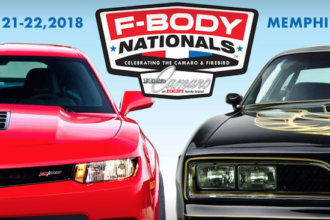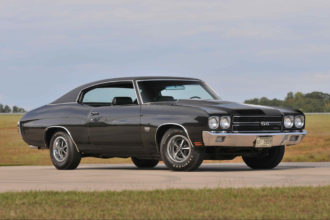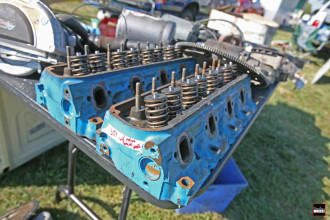photos by: the author
A First-Person Recount of One Pontiac’s Journey
Gearheads often tell similar tales of how their passion was ignited; buckets full of Matchbox and Hot Wheels cars, plastic model kits, and a plethora of other car-related toys foster addictions to four-wheeled machines from a very young age.
However, trying to pinpoint my own affinity towards classic Pontiacs is a bit more difficult. My father, the late Pete B. Bonaskiewich, was a Ford guy (not that there’s anything wrong with that), owning several Mustangs and Rancheros over the course of my childhood. He also provided my mom with a series of gigantic Mercury station wagons from the 1970s; the most memorable was cream colored, and it was massive—probably visible from outer space!—with plenty of room for me and my three older siblings.
At about 14, I was eager to get my driver’s license, and had plenty of Hot Rod and Car Craft magazines to keep me informed. One such publication ran a small article on a 1969 Pontiac Le Mans. Though it wasn’t a large feature spread and the photography was black and white, there was something about that car that grabbed me and never let go.
Shortly after turning 16 in 1993, I got my license and had saved some money from my after-school job with a landscape company, grueling work in Central Florida. After checking out a distressed 1981 Grand Prix, which my father wisely talked me out of, we came across a classified ad for a 1970 Le Mans, which was listed for $1,600 and equipped with a 350 ci engine and TH-350 automatic transmission; we called and went to check it out the next day.
The car was in good condition and a deal was soon reached, making me the proud owner of a ‘new’ 1970 Pontiac Le Mans. White with multi-color pinstripes and chrome ‘baby moon’ hubcaps, it wasn’t perfect, but it was perfect for me. I quickly became fascinated with the car and high school classmates even started calling me ‘Pontiac.’
For most 16-year-old boys, a muscle car is a sure-fire way to get into trouble: with police, parents, school…the list goes on. For me, it had the opposite effect; the relationship with my father grew stronger, and since the car took up much of my spare time, I wasn’t out being a neighborhood nuisance. Sure, there were the occasional burnouts and wide-open throttle bursts, but I valued the car too much to be reckless.
The 350 under the hood was running fine, but I was soon craving more. Another classified ad yielded a 400 ci engine with a TH-350 transmission for a mere $150. I began researching camshafts, cylinder heads, and other modifications to perform. My father and I disassembled the engine and sent it to the local machine shop. The engine was cleaned, magna-fluxed, and bored .060 over. Cam bearings were pressed in and the rotating assembly was balanced. The 6X cylinder heads were treated to a 3-angle valve job and new valve springs were fitted.
Back at home, TRW forged pistons were mated to the reconditioned factory connecting rods and a Crane cam with 216 duration at .050 and .454 lift was employed. The factory cast iron intake, along with the Rochester Quadrajet carburetor, were cleaned and reinstalled.
The engine swap took place over the course of a single weekend, and we were more than excited to hear the 413 ci roar to life. I’ll never forget that distinct aroma of exhaust, fuel, and perhaps a bit of burnt oil when the engine fired up. I enjoyed the increased horsepower, and even went drag racing on occasion, driving 45 miles each way to the track. Dad’s health was beginning to decline around this time and he usually could not accompany me on my trips to the drag strip; I would come home late on Saturday nights and fill him in on the details.
The Le Mans handled daily driving duties until I moved to Orlando in 1998 and didn’t feel comfortable driving it in rush-hour traffic. I purchased a second car, and the Le Mans became strictly a weekend cruiser. Later that year, my father passed away and I decided to pursue other activities completely unrelated to cars.
As time passed, wounds began to slowly heal and I eventually wanted to be back behind the wheel of my Pontiac, but I wanted to restore it properly and own a car that I could be proud of. As a professional automotive paint technician, I was able to handle a majority of the paint and bodywork process myself, but relied on friends and co-workers to handle the metalwork and larger repair areas.
The body of the Le Mans was in good condition, but still required some attention. In 2007, it was stripped with a combination of machine sanding and chemical stripper, exposing six previous paint jobs and rust damage that needed to be addressed. Metal patches were welded in the lower sections of the front fenders and a replacement quarter panel was installed on the driver’s side. The panel between the deck lid and rear window was also replaced due to rust, a common issue on many cars of the era. The hood is an aftermarket fiberglass GTO unit, which required additional prep work prior to painting.
With the metal work completed, a coat of etch primer was sprayed on the entire body, and small dings and dents were repaired. Three coats of Nexa Autocolor 761 urethane primer were then applied and the body was block-sanded with 220-grit sandpaper followed by three more coats of primer. Final sanding was done with 320 and 400-grit sandpaper until the Pontiac was ready for color.
A coat of white PPG sealer was used prior to the code 60, ‘Orbit Orange,’ Nexa Autocolor basecoat application. Two coats of PPG 2021 clear coat were then sprayed and given proper cure time. The original chrome bumpers were also painted body color for a cleaner look. Wet sanding with 2000-grit sandpaper, followed by compound and polishing, resulted in a factory-type finish that retains a small amount of orange peel. GTO Judge ‘eyebrow stripes’ were applied much later and give the Le Mans a classic muscle car appearance.
The interior of the Le Mans has been reconditioned and features a few upgrades. New carpet and door panels were installed and the seats were cleaned and sprayed with black vinyl dye. A new dash pad replaced the old, cracked factory piece and a new headliner was fitted. A Formula steering wheel, 4-speaker stereo, and B&M ratchet shifter provide maximum enjoyment on cruises
In 2012, with the help of my father-in-law, Jim Durs, the brakes and suspension were completely overhauled. The front brakes were converted to disc and feature cross-drilled rotors and single piston calipers. CPP tubular upper and lower control arms were installed and 2-inch drop spindles were used to lower the car for a proper attitude. New coil springs and KYB shocks were installed, along with new bushings and a hefty BMR sway bar.
The rear suspension features 2-inch lowering springs, boxed lower control arms, and a large-diameter BMR sway bar. A 10-bolt posi rear end with factory drum brakes houses the highway friendly 3.08 gears. Rubber is 235/50/17 up front and 275/50/17 out back, mounted on 17×8 and 17×9 American Racing VNT 70 wheels. The wheel and tire combination are a perfect blend of old-school looks with more modern sizes.
Recent upgrades include a dual exhaust featuring 2.5-inch pipes and MagnaFlow mufflers with 1972 GTO-style tips. A Street Demon carburetor and Edelbrock intake manifold were also added within the past few years. Plans for the future involve installing a factory, in-dash tachometer and replacing the CD player with a period correct 8-track system.
This 1970 Pontiac Le Mans has been a huge part of my life for 20+ years and I couldn’t imagine being without it. It’s traveled to numerous events across the state of Florida and recently made the journey from Orlando to Pigeon Forge, Tennessee. My wife and I are now planning a cross-country road trip with our dogs and I can’t wait to get on Historic Route 66 and say, “This is for you, Pops!”
Dave’s a very passionate musclecar aficionado. An automotive painter by trade, he’s done a complete restoration on his very first car, a 1970 Pontiac LeMans that he’s owned for over 20 years. Dave’s superior photographic skills, writing talents and Florida location make him an ideal year-round contributor.


















